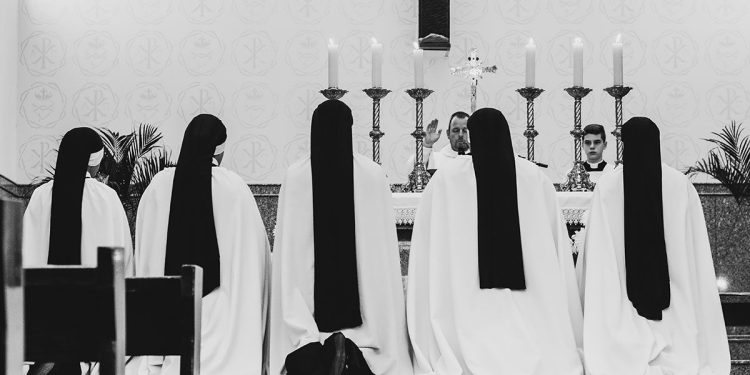The group of Belgium nuns driving a convoy of luxury cars towards their newly purchased villa in the south of France had broken at least two of the deadly sins, according to the Bishop of Bruges, whose lawyers were in hot pursuit. Their apparent transgressions included greed and envy for the riches their simple life of poverty, austerity and seclusion forbade. Wrath may have also been a factor, as the nuns were angered by the bishop’s decision to starve their convent of new recruits, effectively dooming it to eventual closure. Subsequently, the eight sisters plotted a legal coup and sold the historic 600-year-old building from under the Vatican’s nose.
The Bruges nuns, under the leadership of their Mother Superior, Sister Anna Backx, a spritely 61 at the time, pocketed $1.4m for the building, located in the center of Belgium`s picture-postcard medieval city. With the windfall they purchased a fleet of cars including a $110,000 Mercedes limo, racehorses and a chateau and farm in the foothills of the French Pyrenees near Lourdes. They handed the keys to the convent over to the new buyers and set off for warmer climes in the convoy that also included an ambulance to carry Sister Agnes, 93, who could not see, hear, or walk.
It was 1990, but now, for the first time, using documents and court reports, we can tell the full untold story of the millionaire Belgium nuns and the angry Bishops who tried to stop them. The events play out like a Hollywood movie with subplots that include a forbidden lesbian affair, a tense court drama and a child abuse scandal that rumbles on today.
The nuns were from a Catholic order officially called the Order of Saint Clare but generally referred to as the Poor Clares. The order was founded by St Clare of Assisi in 1212. She was the first woman to write a set of monastic guidelines and her house rules were particularly strict, requiring extreme poverty, no property ownership, and total reliance on handouts from the local communities in which her convents were situated.
Despite the severe lifestyle required to become a Poor Clare, communities spread quickly throughout Europe. By 1300 there were 47 convents in Spain alone. The Reformation halted the spread of the Order for a time in Northwest Europe but by the 19th Century Poor Clares were in the ascendent again, particularly in Belgium where the nuns based in Bruges and Ghent established another 26 new convents in the country along with a dozen in England, the Netherlands, Germany and France.
But by 1990 the Belgium nun explosion had slowed to a trickle and the once burgeoning Poor Clares of Bruges convent appeared to be in terminal decline. Only eight sisters remained, ranging in age from 61 to 93. According to reports, the catalyst for their actions was the realization that the bishop’s office had placed their home on a list of convents closed to new recruits. With no fresh blood and ageing residents, the designation was effectively a ‘do not resuscitate’ order. When the last nun died, the convent died with her and the property and everything in it returned to the diocese. Church authorities later argued that there were simply not enough young women joining the sisterhood to maintain the convent and that although the inhabitants of the convent were old, they could have lived there for ‘many more years’. The nuns saw it differently. In later testimony, Sister Josephine, described by lawyers as ‘very clear of mind, not senile’ explained the rationale behind what happened next. “Why should we just let it bleed to death and let the diocese get all the goods back?”
The wily nuns spotted a solution in the arcane statutes that controlled the running of the convent. Under the existing by-laws, the diocese of Bruges stood to receive the property and any goods within it after the death of the sisters. But as the convent was classed as a non-profit organization, the nuns were able to change the by-laws without permission from the Diocese and became its legal owners. They were then free to sell it. They found buyers, a partnership of textile firms, and enlisted the help of a financial advisor named Ronny Crab.
In the subsequent spending spree, with Crab’s help, they bought a chateau in the south of France and a farm, 11 racehorses and six luxury cars including three Mercedes-Benz models equipped with telephones and televisions. As none of them could drive they travelled to their new home in a $110,000 Mercedes limousine. The remaining money was put in accounts.
When news of the scandal reached the Bishop of Bruges, Rev. Roger Vangheluwe, who started legal proceedings to recover the property and any artifacts within it. Reports state that several paintings had also disappeared from the convent, along with the nuns.
Incredibly it wasn’t the only convent controversy the bishop was dealing with at the time. In the coastal town of Nieuwport, 40kms away, another superfluity of Poor Clares, led by their cigar chomping Mercedes-driving Mother Superior, had purchased a disused wing of their convent and turned it into a $100-a-night luxury hotel complete with Persian rugs, antiques, marble bathrooms, a conference center, restaurant and leisure center.
Vangheluwe claimed the sale of the Bruge convent was null and void because the Vatican did not approve it, but legal opinion was divided. At the behest of the church, police launched an investigation, and a complaint was made against Crab, who was accused of assaulting a novice nun, forgery, fraud and breach of confidence. He was arrested on February 27, 1990, while investigators were dispatched to France to question the nuns. In Bruges cops seized historic artifacts from the convent that the nuns had left behind.
The group of Belgium nuns driving a convoy of luxury cars towards their newly purchased villa in the south of France had broken at least two of the deadly sins, according to the Bishop of Bruges, whose lawyers were in hot pursuit. Their apparent transgressions included greed and envy for the riches their simple life of poverty, austerity and seclusion forbade. Wrath may have also been a factor, as the nuns were angered by the bishop’s decision to starve their convent of new recruits, effectively dooming it to eventual closure. Subsequently, the eight sisters plotted a legal coup and sold the historic 600-year-old building from under the Vatican’s nose.
The Bruges nuns, under the leadership of their Mother Superior, Sister Anna Backx, a spritely 61 at the time, pocketed $1.4m for the building, located in the center of Belgium`s picture-postcard medieval city. With the windfall they purchased a fleet of cars including a $110,000 Mercedes limo, racehorses and a chateau and farm in the foothills of the French Pyrenees near Lourdes. They handed the keys to the convent over to the new buyers and set off for warmer climes in the convoy that also included an ambulance to carry Sister Agnes, 93, who could not see, hear, or walk.
It was 1990, but now, for the first time, using documents and court reports, we can tell the full untold story of the millionaire Belgium nuns and the angry Bishops who tried to stop them. The events play out like a Hollywood movie with subplots that include a forbidden lesbian affair, a tense court drama and a child abuse scandal that rumbles on today.
The nuns were from a Catholic order officially called the Order of Saint Clare but generally referred to as the Poor Clares. The order was founded by St Clare of Assisi in 1212. She was the first woman to write a set of monastic guidelines and her house rules were particularly strict, requiring extreme poverty, no property ownership, and total reliance on handouts from the local communities in which her convents were situated.
Despite the severe lifestyle required to become a Poor Clare, communities spread quickly throughout Europe. By 1300 there were 47 convents in Spain alone. The Reformation halted the spread of the Order for a time in Northwest Europe but by the 19th Century Poor Clares were in the ascendent again, particularly in Belgium where the nuns based in Bruges and Ghent established another 26 new convents in the country along with a dozen in England, the Netherlands, Germany and France.
But by 1990 the Belgium nun explosion had slowed to a trickle and the once burgeoning Poor Clares of Bruges convent appeared to be in terminal decline. Only eight sisters remained, ranging in age from 61 to 93. According to reports, the catalyst for their actions was the realization that the bishop’s office had placed their home on a list of convents closed to new recruits. With no fresh blood and ageing residents, the designation was effectively a ‘do not resuscitate’ order. When the last nun died, the convent died with her and the property and everything in it returned to the diocese. Church authorities later argued that there were simply not enough young women joining the sisterhood to maintain the convent and that although the inhabitants of the convent were old, they could have lived there for ‘many more years’. The nuns saw it differently. In later testimony, Sister Josephine, described by lawyers as ‘very clear of mind, not senile’ explained the rationale behind what happened next. “Why should we just let it bleed to death and let the diocese get all the goods back?”
The wily nuns spotted a solution in the arcane statutes that controlled the running of the convent. Under the existing by-laws, the diocese of Bruges stood to receive the property and any goods within it after the death of the sisters. But as the convent was classed as a non-profit organization, the nuns were able to change the by-laws without permission from the Diocese and became its legal owners. They were then free to sell it. They found buyers, a partnership of textile firms, and enlisted the help of a financial advisor named Ronny Crab.
In the subsequent spending spree, with Crab’s help, they bought a chateau in the south of France and a farm, 11 racehorses and six luxury cars including three Mercedes-Benz models equipped with telephones and televisions. As none of them could drive they travelled to their new home in a $110,000 Mercedes limousine. The remaining money was put in accounts.
When news of the scandal reached the Bishop of Bruges, Rev. Roger Vangheluwe, who started legal proceedings to recover the property and any artifacts within it. Reports state that several paintings had also disappeared from the convent, along with the nuns.
Incredibly it wasn’t the only convent controversy the bishop was dealing with at the time. In the coastal town of Nieuwport, 40kms away, another superfluity of Poor Clares, led by their cigar chomping Mercedes-driving Mother Superior, had purchased a disused wing of their convent and turned it into a $100-a-night luxury hotel complete with Persian rugs, antiques, marble bathrooms, a conference center, restaurant and leisure center.
Vangheluwe claimed the sale of the Bruge convent was null and void because the Vatican did not approve it, but legal opinion was divided. At the behest of the church, police launched an investigation, and a complaint was made against Crab, who was accused of assaulting a novice nun, forgery, fraud and breach of confidence. He was arrested on February 27, 1990, while investigators were dispatched to France to question the nuns. In Bruges cops seized historic artifacts from the convent that the nuns had left behind.
The group of Belgium nuns driving a convoy of luxury cars towards their newly purchased villa in the south of France had broken at least two of the deadly sins, according to the Bishop of Bruges, whose lawyers were in hot pursuit. Their apparent transgressions included greed and envy for the riches their simple life of poverty, austerity and seclusion forbade. Wrath may have also been a factor, as the nuns were angered by the bishop’s decision to starve their convent of new recruits, effectively dooming it to eventual closure. Subsequently, the eight sisters plotted a legal coup and sold the historic 600-year-old building from under the Vatican’s nose.
The Bruges nuns, under the leadership of their Mother Superior, Sister Anna Backx, a spritely 61 at the time, pocketed $1.4m for the building, located in the center of Belgium`s picture-postcard medieval city. With the windfall they purchased a fleet of cars including a $110,000 Mercedes limo, racehorses and a chateau and farm in the foothills of the French Pyrenees near Lourdes. They handed the keys to the convent over to the new buyers and set off for warmer climes in the convoy that also included an ambulance to carry Sister Agnes, 93, who could not see, hear, or walk.
It was 1990, but now, for the first time, using documents and court reports, we can tell the full untold story of the millionaire Belgium nuns and the angry Bishops who tried to stop them. The events play out like a Hollywood movie with subplots that include a forbidden lesbian affair, a tense court drama and a child abuse scandal that rumbles on today.
The nuns were from a Catholic order officially called the Order of Saint Clare but generally referred to as the Poor Clares. The order was founded by St Clare of Assisi in 1212. She was the first woman to write a set of monastic guidelines and her house rules were particularly strict, requiring extreme poverty, no property ownership, and total reliance on handouts from the local communities in which her convents were situated.
Despite the severe lifestyle required to become a Poor Clare, communities spread quickly throughout Europe. By 1300 there were 47 convents in Spain alone. The Reformation halted the spread of the Order for a time in Northwest Europe but by the 19th Century Poor Clares were in the ascendent again, particularly in Belgium where the nuns based in Bruges and Ghent established another 26 new convents in the country along with a dozen in England, the Netherlands, Germany and France.
But by 1990 the Belgium nun explosion had slowed to a trickle and the once burgeoning Poor Clares of Bruges convent appeared to be in terminal decline. Only eight sisters remained, ranging in age from 61 to 93. According to reports, the catalyst for their actions was the realization that the bishop’s office had placed their home on a list of convents closed to new recruits. With no fresh blood and ageing residents, the designation was effectively a ‘do not resuscitate’ order. When the last nun died, the convent died with her and the property and everything in it returned to the diocese. Church authorities later argued that there were simply not enough young women joining the sisterhood to maintain the convent and that although the inhabitants of the convent were old, they could have lived there for ‘many more years’. The nuns saw it differently. In later testimony, Sister Josephine, described by lawyers as ‘very clear of mind, not senile’ explained the rationale behind what happened next. “Why should we just let it bleed to death and let the diocese get all the goods back?”
The wily nuns spotted a solution in the arcane statutes that controlled the running of the convent. Under the existing by-laws, the diocese of Bruges stood to receive the property and any goods within it after the death of the sisters. But as the convent was classed as a non-profit organization, the nuns were able to change the by-laws without permission from the Diocese and became its legal owners. They were then free to sell it. They found buyers, a partnership of textile firms, and enlisted the help of a financial advisor named Ronny Crab.
In the subsequent spending spree, with Crab’s help, they bought a chateau in the south of France and a farm, 11 racehorses and six luxury cars including three Mercedes-Benz models equipped with telephones and televisions. As none of them could drive they travelled to their new home in a $110,000 Mercedes limousine. The remaining money was put in accounts.
When news of the scandal reached the Bishop of Bruges, Rev. Roger Vangheluwe, who started legal proceedings to recover the property and any artifacts within it. Reports state that several paintings had also disappeared from the convent, along with the nuns.
Incredibly it wasn’t the only convent controversy the bishop was dealing with at the time. In the coastal town of Nieuwport, 40kms away, another superfluity of Poor Clares, led by their cigar chomping Mercedes-driving Mother Superior, had purchased a disused wing of their convent and turned it into a $100-a-night luxury hotel complete with Persian rugs, antiques, marble bathrooms, a conference center, restaurant and leisure center.
Vangheluwe claimed the sale of the Bruge convent was null and void because the Vatican did not approve it, but legal opinion was divided. At the behest of the church, police launched an investigation, and a complaint was made against Crab, who was accused of assaulting a novice nun, forgery, fraud and breach of confidence. He was arrested on February 27, 1990, while investigators were dispatched to France to question the nuns. In Bruges cops seized historic artifacts from the convent that the nuns had left behind.
The group of Belgium nuns driving a convoy of luxury cars towards their newly purchased villa in the south of France had broken at least two of the deadly sins, according to the Bishop of Bruges, whose lawyers were in hot pursuit. Their apparent transgressions included greed and envy for the riches their simple life of poverty, austerity and seclusion forbade. Wrath may have also been a factor, as the nuns were angered by the bishop’s decision to starve their convent of new recruits, effectively dooming it to eventual closure. Subsequently, the eight sisters plotted a legal coup and sold the historic 600-year-old building from under the Vatican’s nose.
The Bruges nuns, under the leadership of their Mother Superior, Sister Anna Backx, a spritely 61 at the time, pocketed $1.4m for the building, located in the center of Belgium`s picture-postcard medieval city. With the windfall they purchased a fleet of cars including a $110,000 Mercedes limo, racehorses and a chateau and farm in the foothills of the French Pyrenees near Lourdes. They handed the keys to the convent over to the new buyers and set off for warmer climes in the convoy that also included an ambulance to carry Sister Agnes, 93, who could not see, hear, or walk.
It was 1990, but now, for the first time, using documents and court reports, we can tell the full untold story of the millionaire Belgium nuns and the angry Bishops who tried to stop them. The events play out like a Hollywood movie with subplots that include a forbidden lesbian affair, a tense court drama and a child abuse scandal that rumbles on today.
The nuns were from a Catholic order officially called the Order of Saint Clare but generally referred to as the Poor Clares. The order was founded by St Clare of Assisi in 1212. She was the first woman to write a set of monastic guidelines and her house rules were particularly strict, requiring extreme poverty, no property ownership, and total reliance on handouts from the local communities in which her convents were situated.
Despite the severe lifestyle required to become a Poor Clare, communities spread quickly throughout Europe. By 1300 there were 47 convents in Spain alone. The Reformation halted the spread of the Order for a time in Northwest Europe but by the 19th Century Poor Clares were in the ascendent again, particularly in Belgium where the nuns based in Bruges and Ghent established another 26 new convents in the country along with a dozen in England, the Netherlands, Germany and France.
But by 1990 the Belgium nun explosion had slowed to a trickle and the once burgeoning Poor Clares of Bruges convent appeared to be in terminal decline. Only eight sisters remained, ranging in age from 61 to 93. According to reports, the catalyst for their actions was the realization that the bishop’s office had placed their home on a list of convents closed to new recruits. With no fresh blood and ageing residents, the designation was effectively a ‘do not resuscitate’ order. When the last nun died, the convent died with her and the property and everything in it returned to the diocese. Church authorities later argued that there were simply not enough young women joining the sisterhood to maintain the convent and that although the inhabitants of the convent were old, they could have lived there for ‘many more years’. The nuns saw it differently. In later testimony, Sister Josephine, described by lawyers as ‘very clear of mind, not senile’ explained the rationale behind what happened next. “Why should we just let it bleed to death and let the diocese get all the goods back?”
The wily nuns spotted a solution in the arcane statutes that controlled the running of the convent. Under the existing by-laws, the diocese of Bruges stood to receive the property and any goods within it after the death of the sisters. But as the convent was classed as a non-profit organization, the nuns were able to change the by-laws without permission from the Diocese and became its legal owners. They were then free to sell it. They found buyers, a partnership of textile firms, and enlisted the help of a financial advisor named Ronny Crab.
In the subsequent spending spree, with Crab’s help, they bought a chateau in the south of France and a farm, 11 racehorses and six luxury cars including three Mercedes-Benz models equipped with telephones and televisions. As none of them could drive they travelled to their new home in a $110,000 Mercedes limousine. The remaining money was put in accounts.
When news of the scandal reached the Bishop of Bruges, Rev. Roger Vangheluwe, who started legal proceedings to recover the property and any artifacts within it. Reports state that several paintings had also disappeared from the convent, along with the nuns.
Incredibly it wasn’t the only convent controversy the bishop was dealing with at the time. In the coastal town of Nieuwport, 40kms away, another superfluity of Poor Clares, led by their cigar chomping Mercedes-driving Mother Superior, had purchased a disused wing of their convent and turned it into a $100-a-night luxury hotel complete with Persian rugs, antiques, marble bathrooms, a conference center, restaurant and leisure center.
Vangheluwe claimed the sale of the Bruge convent was null and void because the Vatican did not approve it, but legal opinion was divided. At the behest of the church, police launched an investigation, and a complaint was made against Crab, who was accused of assaulting a novice nun, forgery, fraud and breach of confidence. He was arrested on February 27, 1990, while investigators were dispatched to France to question the nuns. In Bruges cops seized historic artifacts from the convent that the nuns had left behind.










Discussion about this post